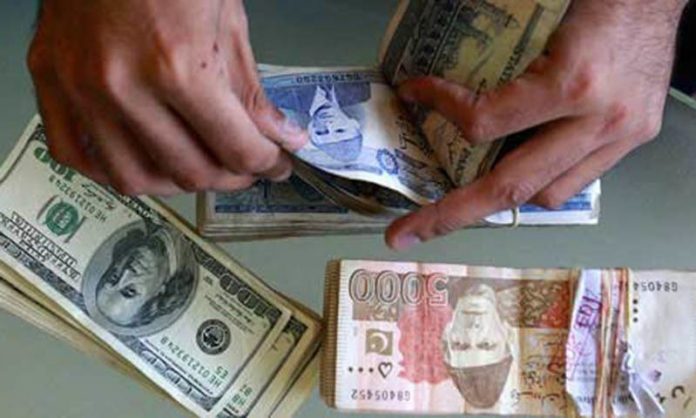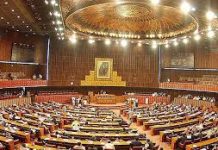
LAHORE: The rupee continued its spree of nosediving against the dollar, as the local currency depreciated further in the inter-bank market to an intraday high of Rs122.00 on Thursday before closing at Rs121.50.
During the last week of Ramazan, the rupee has plunged by Rs5.64 against the dollar. In the last six months has depreciated 14 percent against the greenback and market experts are expecting further devaluation after Eid.
The inter-bank market on Thursday was jolted further as it touched a new low in the closing hours of trading when normally commercial banks buy and sell large volumes of foreign currencies, especially US dollars because of commercial importers.
And the unpredictable situation compelled kerb market currency dealers to willingly stop the sale of foreign currencies.
However, when currency trading restarted the rupee hit a new low against the dollar in the kerb market, closing at Rs124.
As per the central bank, the rupee had plummeted by 4.13 percent against the dollar when it stood at Rs120.39 to the greenback on Monday.
However, Exchange Companies of Pakistan (ECAP) General Secretary Zafar Paracha told a national daily that the rupee’s value diminished by 1.6 percent against the greenback in the kerb market compared to Wednesday’s closing rate of Rs122.
Pakistan Forex Association (PFA) President Malik Bostan said currency traders are expecting the rupee to further devalue against the dollar to Rs125.
For the second consecutive week, the State Bank of Pakistan’s foreign exchange reserves rose 0.24 percent on a weekly basis, as per data released by the central bank on Thursday.
The forex reserves had been on a continuous decline since last few weeks and fell significantly, creating worries over the country’s ability to meet future payment obligations and managing a widening current account deficit (CAD).
The total liquid foreign reserves of the country stood at dollars $16.457 billion and foreign reserves held by the State Bank on June 8th, amounted to $10,065.6 million.
Whereas, the net foreign reserves with commercial banks were $6,391.5 million. During the week ending June 8, SBP’s reserves increased by $24 million to $10,066 million.
Due to a 10 percent devaluation of the rupee against the dollar in December 2017 and March 2018, Rs775 billion were added to the public debt and this figure is expected to rise further with this week’s depreciation.
Previously, credit rating agency Moody’s in May projected the rupee could plunge by 7.75 percent and touch Rs125 to the dollar by June 2019.
Also, Pakistan’s current account deficit touched a record high of $14.03 billion during the first ten months (July-April) of FY18, widening by 50 percent.
An increase in current account deficit impacts foreign exchange reserves and the country’s external debt and liabilities touched a record high of $91.8 billion by end of March 2018, according to an SBP report last month.
The central bank in a press release issued after trading close on Monday said “An official press release issued by the central bank said “Today, the PKR-US$ exchange rate in the interbank market closed at PKR 119.84 per US$ while witnessing an intraday low and high of PKR 117.00 and PKR 121.50 per US$ respectively. This movement is based on foreign exchange demand-supply gap in the interbank market.”
The State Bank of Pakistan added “The market-based adjustment is reflective of the country’s external Balance of Payments position which is under pressure due to a large trade deficit. Despite the continued growth in exports (13.3 percent in Jul-Apr FY18) and some uptick in remittances, growing imports have pushed the current account deficit to US$ 14.0 billion during the first ten months of FY18, which is 1.5 times the level of deficit realized during the same period last year.”
The central bank believed “this market-driven adjustment in the exchange rate along with other recent policy measures are expected to contain the imbalances in the external account thereby containing aggregate demand and also facilitate the prospects for generating non-debt creating inflows.”
The government had devalued the rupee by around 5 percent on Dec 8th, 2017 to Rs110 and then again by around 4.5 percent to Rs115 on Mar 20, 2018.
In the last decade, the rupee has devalued annually by around 5 percent.
In mid-April, while visiting Washington for IMF’s spring meeting’s, former finance minister Dr Miftah Ismail in an interview to Bloomberg TV said rupee had attained its “optimal value” and wouldn’t require further devaluation.
A United Nations report in December last year had warned Pakistan’s policy of keeping the rupee stable could become untenable if the US dollar appreciated against other world currencies and could possibly erode the country’s foreign exchange reserves.





















Comedy desk : June 10, 2018 at 10:23 am
PKR USD (plus minus 5percent historical open market rate averages )
1968 = Rs 5.00
1978 = 10.00
1988 = 20.00
1998(January ) = 40.00
2008 (November ) = 80.00
2018 = ????
If we observe the pattern it should be 160 after elections .
Dont want to get the currecny devaluated up to that extent of pro-rata like 1usd=160 this year.
Just want Pkr should be stable and we want to make policies by curtailing the foreign debts and more and more foreign remittances to Pakistan.
Govt. Should make strategies to a strict message and new lsunch of MADE IN PAKISTAN , AND USE ONLY PAKISTANI MADE…. this would help PAKISTAN TO STABILIZE AND GROW MORE… WE DONT WANT ANYTHING LIKE PTI AND PLMN.
Comments are closed.